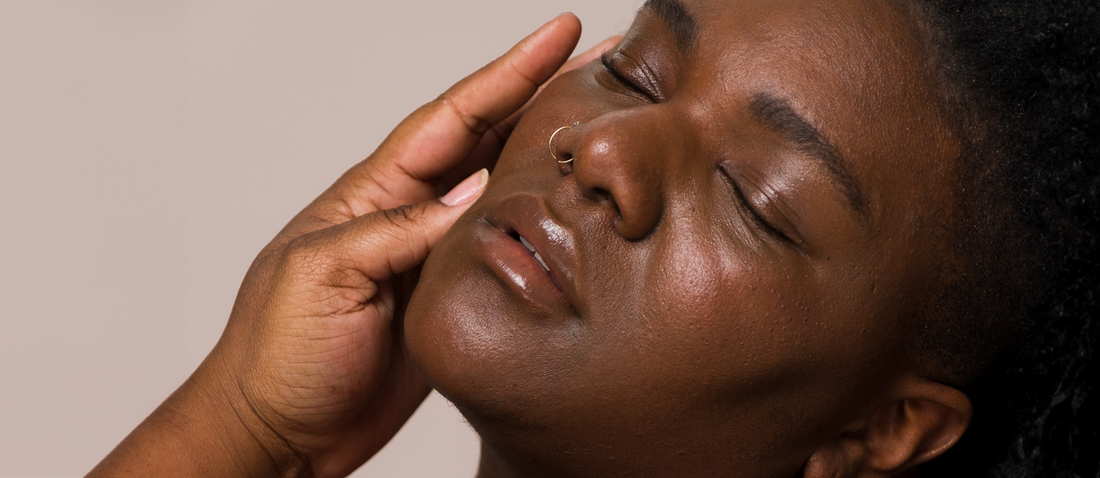The human body is an expert in producing all the good stuff we need to survive and thrive. That said, sometimes it’s not the best at knowing when enough is enough.
Sebum is a natural oil produced by our skin glands to keep the epidermis dewy and hydrated. But when too much sebum accumulates on the face, you’re left with greasy, oily skin. All too often, acne doesn’t take long to follow after excess oil.
If you have oily skin, you may think it’s just a curse you’ll have to surrender to, but this is not the case. With a few strategic lifestyle changes and high-quality skincare products on your side, you can learn about oily skin treatment options, take back control of your complexion, and enjoy some much-needed relief from the struggles of sebum secretion and overproduction of excess oil.
UNDERSTANDING SEBUM: WHAT IT IS AND WHY IT MATTERS
The culprits behind skin problems that stem from excessive oil are none other than our sebaceous glands. The sebaceous gland produces an oily substance called sebum to keep our skin moisturized and protected.
Unfortunately, like anything in life, too much of a good thing can cause problems. When excess sebum is produced, a pore can quickly become clogged, instigating the formation of stubborn acne.
CAUSES OF EXCESSIVE SEBUM PRODUCTION
So why do our sebaceous glands sometimes kick into overdrive? Two of the most common factors that can influence excessive sebum secretion include:
Stage of life
Sebum production fluctuates as you grow up and undergo hormonal transitions. The sebum our glands secrete dramatically increases when we go through puberty and doesn’t decline again until the age of menopause for women and the sixth or seventh decade of life for men.
Environmental factors
Research shows that humidity can contribute to the sebaceous gland’s overproduction of oil. If you live in a particularly hot and moist climate, you may be more prone to oily skin.
Many of the factors that contribute to oily skin lie outside of your control. In fact, some people are simply genetically predisposed to have oilier skin.
Instead of focusing on the factors you can’t change, put your time and energy into adopting positive practices that will noticeably improve your skin condition.
HEALTHY HABITS FOR MANAGING SEBUM PRODUCTION
Did you know that certain lifestyle factors can exacerbate the severity of overly oily skin?
There’s no singular rulebook on how to reduce sebum production. However, 5 of the most effective things you can do to set your skin up for success are:
- Reducing your stress to limit cortisol production, which can stimulate sebum
- Limiting your intake of alcohol, which can enlarge the oil glands
- Avoiding going to sleep without removing the day’s makeup
- Steering clear of high glycemic foods and beverages that stimulate sebum production
- Using blotting paper on your face to absorb excess oils
Making a habit of these healthy skin practices is the first step toward managing oily skin.
But one of the simplest yet most effective strategies you can put into place to help clear up oily skin is investing in trusted skincare products formulated by experts. The right solutions will penetrate deep to tackle excess sebum at the root and provide real results.
Next, we’ll dive into our top recommendations for oily skin treatment options you should add to your skincare routine ASAP.
SKINCARE SOLUTIONS FOR OILY SKIN
Invest in high-quality skincare solutions in the following 4 areas to give your skin the assistance it needs to recover from excess sebum production:
Cleanser
Honesty hour: have you ever tried to banish your facial oil by scrubbing hard with a harsh cleanser? It’s a common strategy, but this can actually make the problem worse. Dermatologists recommend using a gentle cleanser for oily skin to avoid triggering increased oil production. Our Gentle Gel Cleanser is a low-sud solution that won’t strip or dehydrate your delicate facial skin.
Moisturizer
Many people mistakenly jump to the conclusion that adding moisturizer to an already oily face is counterproductive. However, this is nothing more than a myth. When skin detects that it’s getting dried out, it often goes into panic mode and produces even more sebum to overcompensate. Keep your skin hydrated and happy with our HERO Peptide Moisturizer, a non-greasy product ideal for soothing irritated oily skin.
Topical treatments
Special products applied directly to the surface of the skin can be incredibly effective for combating oil-related breakouts. One powerful over-the-counter medication that works wonders on oily skin is benzoyl peroxide. This treatment kills acne bacteria living on the skin and inside of hair follicles. Our RESET Acne Treatment Gel, available in a gentler 2.8% Benzoyl Peroxide concentration and a strong 5% Benzoyl Peroxide version, is an ideal topical skincare solution.
Retinoids
Few treatments combat oily skin as well as retinoids. Retinoids encourage cell turnover, helping to thicken the epidermis, keep the skin plump, stimulate collagen production, and block inflammatory pathways that can contribute to acne. For those wondering about retinoid vs retinol and their respective benefits in skincare, it's important to understand how each ingredient works to combat oily skin and acne. Add THE FIX Revital A, a retinoid cream, to your skincare routine to clear congested pores. Our 101 Gentle Retinoid is also a reliable source of acne-fighting properties.
SUPPORT YOUR SKIN WITH SEVEN:THIRTY SOLUTIONS
If your skin is overdoing it in the oil-production department, don’t sweat it. The expert chemists behind our Seven:Thirty skincare products have carefully curated smart solutions to help you target and treat stubborn oily skin.
Consistency and quality are paramount when it comes to skincare. Explore our line of cleansers, moisturizers, and retinoids to say goodbye to excess sebum and achieve the radiant skin you deserve.
Sources:
National Library of Medicine. Oily Skin: A review of Treatment Options. https://www.ncbi.nlm.nih.gov/pmc/articles/PMC5605215/
Medical News Today. 19 ways to get rid of oily skin. https://www.medicalnewstoday.com/articles/how-to-get-rid-of-oily-skin
American Academy of Dermatology Association. HOW TO CONTROL OILY SKIN. https://www.aad.org/public/everyday-care/skin-care-basics/dry/oily-skin
National Library of Medicine. Benzoyl Peroxide. https://www.ncbi.nlm.nih.gov/books/NBK537220/

